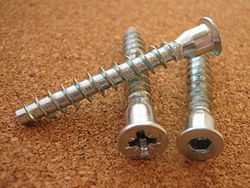



Confirmat screws or cabinet-connecting screws [1] are screws designed to hold in particleboard, medium-density fiberboard, and similar materials. [2] They are very common in furniture assembly, but are rare in retail. [2] They may have flat or barrel heads. [3] They have blunt tips, large shanks, and often a shoulder, a broad length of unthreaded shank just below the head, which helps hold the screw in position. [2] They have coarse threads, rather like masonry screws (which may match them exactly in thread).
Contents
Confirmat screws are usually screwed into stepped, predrilled holes, [3] often drilled with a stepped bit. [2] Short, shoulderless confirmat screws, whose heads pass through hardware like hinges or drawer slides, may go into unstepped holes. [2]
As they are screwed in, confirmat screws compress a thread (the spiral groove) into the particle board. They do not cut new threads if removed and re-inserted. A confirmat screw can therefore be removed and replaced dozens of times. [4] However, a confirmat screw can not be replaced by a confirmat screw with a different thread, or it will destroy the threading of the hole (filling the hole with a wooden dowel and using a woodscrew can fix a stripped hole [2] ).
Confirmats may be made of steel, galvanised steel, and nickel and aluminium-zinc alloys. [5] They commonly come in lengths of 40, 50 and 70 millimetres (1.6, 2.0 and 2.8 in), and in shank sizes of 5, 6.3 and 7 millimetres (0.20, 0.25 and 0.28 in), with Phillips drive or hex heads. [4]
Ordinary wood screws do not hold well in particleboard, which is much weaker than wood. They tend to tear out. [6] Confirmat screws have about twice the shank diameter of woodscrews. Drywall screws, while half the price of confirmat screws, do not hold as well in particleboard-like materials, and cannot be removed and re-inserted. Cam-and-bolt connectors can be swapped out, but are more complex and expensive; [4] confirmat manufacturers say that cams are also weaker than confirmats, if better than drywall screws. [4] [ independent source needed ]
Confirmat screws were formerly under patent, but the patent has expired, and they are now made by many companies. [4]